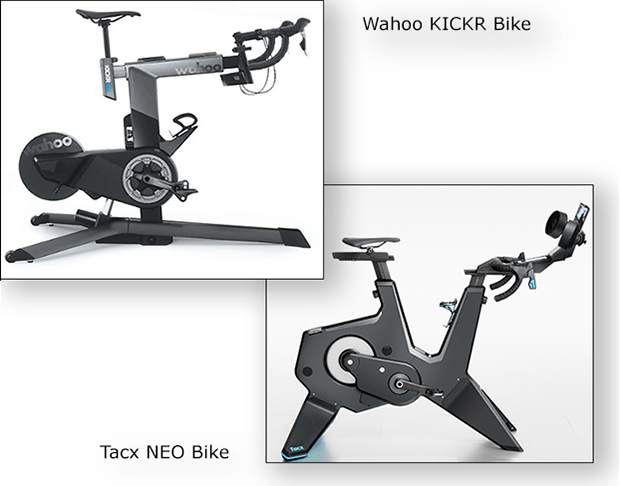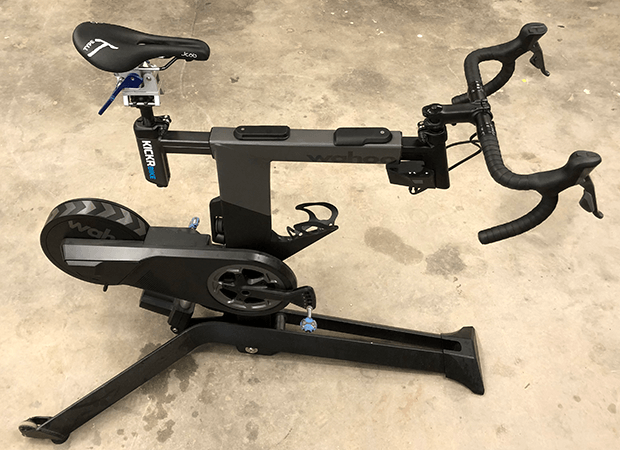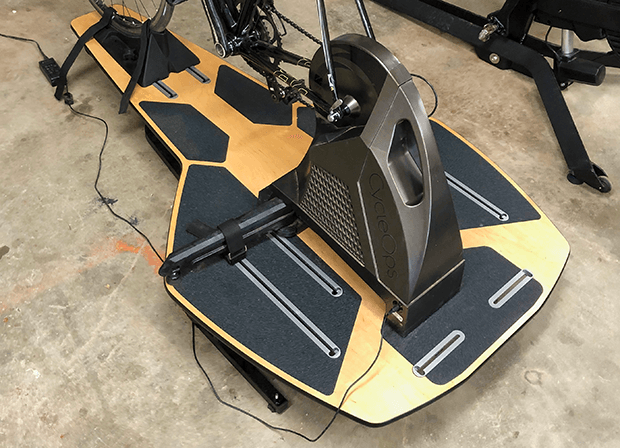Tacx NEO Bike Long Term Review
If I ever do a “long term review,” it means I really dug what I’m reviewing. Why? Because if I don’t like some janky-arse product why would I use it for a “long term”? Life’s too short. At least my life is. More precisely my life’s remainder is too short. It is therefore no mystery why my last two “long term” reviews have been of this industry’s overwhelmingly best-in-class, best-of-year products: The Wahoo KICKR Bike and this, the Tacx NEO Bike. But I’m not going to blow smoke up anybody’s skirt today. There are things I don’t like about this bike and I’ll write them all below. That established…
Two things happened at roughly the same time and one of those things was spectacularly, once-in-a-century, bad: the COVID-19 pandemic. The other was good: the advent of the smart bike. If we have to remain indoors and at-home, the smart bike is – full stop – the best way to ride stationary. In fact if you hop on one of these it won’t be full stop for you, it’ll be full go. Ba Dum Tss!
I base this on having ridden a lot on a pair of smart bikes: the Wahoo KICKR Bike and the Tacx NEO Bike.
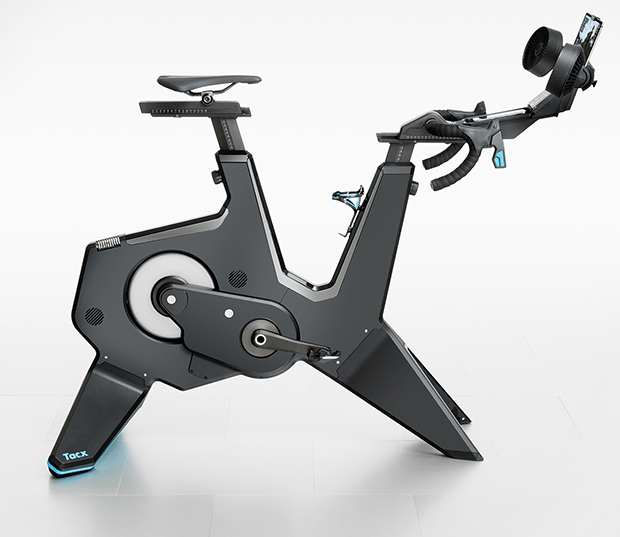
I’ve already written about this bike in the shootout between these two industry leading bikes. But now it’s just the Tacx NEO Bike by itself I’m writing about, what’s good about it; what I don’t like about it; what features it has and doesn’t have.
Can I give you the bottom line now? If what you want is a stationary experience that is unmatched during normal riding, this is it. This is the unit. No stationary product I’ve ridden matches the ride quality of this bike. It is stable; solid; the resistance delivered is accurate; it’s comfortable; it’s roadlike; it’s perfect. Or if it’s not, I don’t know what perfection is because perfection sits on some scale of which I’m unaware.
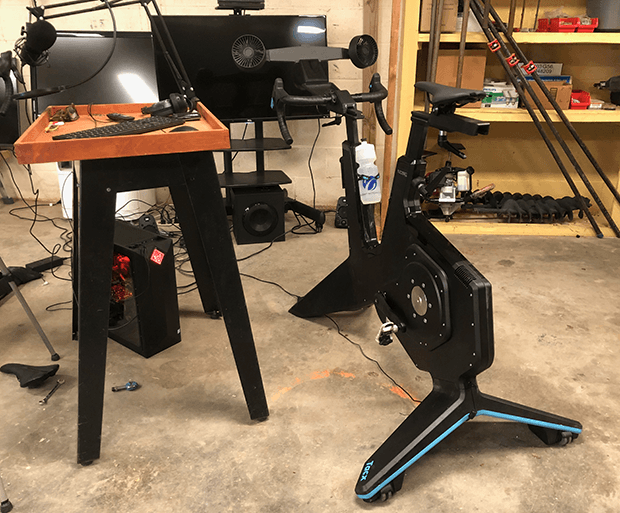
This is what’s good about the bike, and above you can see what this bike looks like set up in the messy Slowtwitch Stationary Workshop. Now let me tell you evvvverrrryyything less good about the bike that I’ve uncovered, so you can process it, know what you’re in for, and make a decision. And I’m asking people to inform us of their decision now, if you’re reading this review at the moment of its publication. What bike are you getting next? That’s our current poll. Two interesting things: 1) As of this writing, you’re getting a gravel bike next. That’s your next bike, way more than any other. Yet, about 1-in-10 if you are getting a smart bike – i.e., this bike or a KICKR Bike – before you get any sort of outdoor bike. Which is why these smart stationary bikes are so hard to get right now!
Back to what’s not industry leading about this bike.
The shifting on the Tacx NEO bike is not as intuitive as I’d like and, at present, not subject to a settings change. It’s certainly something one can get used to. I acclimated. But that’s the thing: It would be nice to not have to acclimate to a product.
The shifting buttons are here, in blue. Big and little. That's upshift and downshift. Cassette shifting on the right lever, front derailleur shifting on the left lever. On one lever, the larger button is upshift and on the other paddle the larger paddle is downshift. I can almost promise you – I don't know this for a fact but I'm almost-promising you anyway, by intuition – these shift paddles will become programmable at some time in the future. As of now, I can certainly live with how they currently shift.
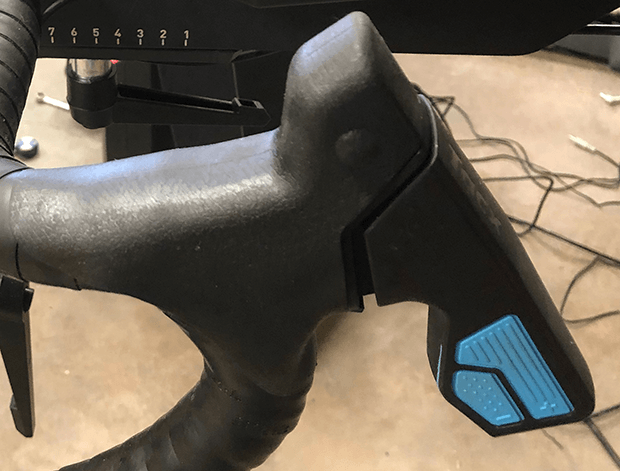
The crank is adjustable, but not in a wide enough range (170mm to 175mm), and it’s adjustable with a piece on the front and back of the pedal eye that are not hard-attached to the crank. If you lose one of these pieces I don’t see how the bike is rideable until you find a replacement. There are extra pieces for other crank lengths that you must keep track of, that is, there’s a hardware set for 172.5mm, and then another for 170mm and 175mm (you just reverse the pieces and they’re either one length or the other). There are many ways to make an adjustable crankset, I’ve used them all, and they’re all superior to this method. This is not a deal breaker, but it was an unforced error.
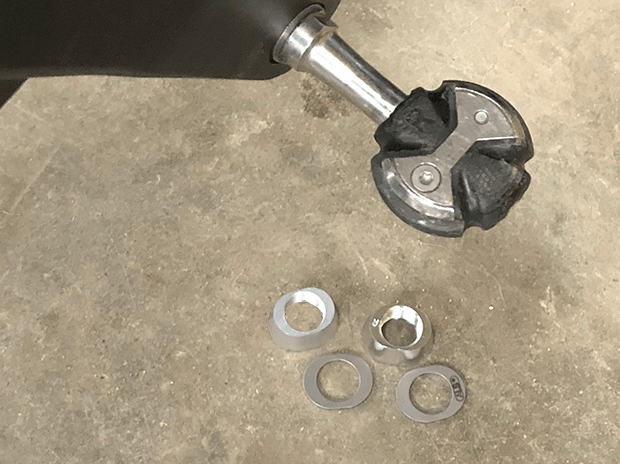
The fans need their own on-off switch. From the cockpit of the bike, while you’re riding. The only way to keep the fans from blowing is to yank the radio jacks out from the front of the bike where they plug in (image of what those radio jacks look like below, and this is from the front of the bike); or you can disable them in the Tacx Utility app. But the bike doesn’t support multiple concurrent BLE connections, and the bike is already connected to a computer via BLE, if you’re riding (say) in Zwift. So, if you’re in the middle of a Zwift or Rouvy ride, the bike can’t talk to the app at all. For any reason. Let alone disabling the fan.
That established, at least this bike has a fan. Actually, a pair of them, which are adjustable via the Tacx Utility App. You can omit them from the build-up of this bike if you don't like them. I like them. Just, since Tacx gave them to me I'm whining a little about how I'd like them to function in the ideal.
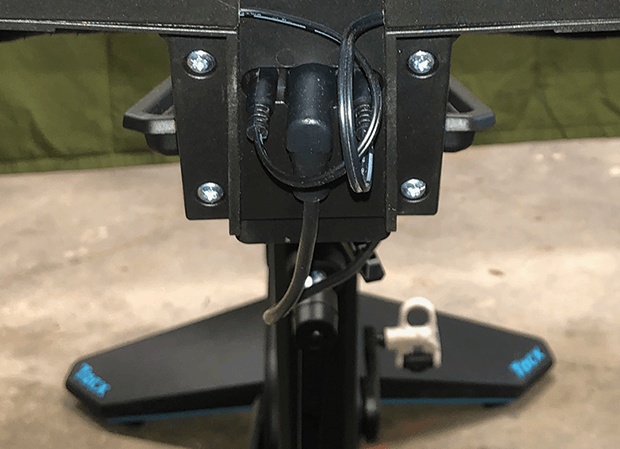
Then there are features the bike doesn’t have. Such as incline/decline, and when I talk to Slowtwitchers this is one feature that causes many of you to say, “Game over! I’m getting a KICKR because it inclines!” I get that. I have no quarrel with your decision.
And, it’s questionable how ubiquitous Tacx’s road feel feature, which is one of the big things Tacx does. This feature works in Zwift. It works in Tacx Films of course. Platforms beyond these? I’m not sure.
If you aren't aware of this feature, if in Zwift you're cruising over rideable dirt, going over a wood plank bridge, rolling over a cattle guard, the NEO replicates the road feel of all of these, and you can program in the Tacx Utility App exactly how much road feel you'll get. This has been a feature of the NEO trainer and is unmatched in the industry, to my knowledge.
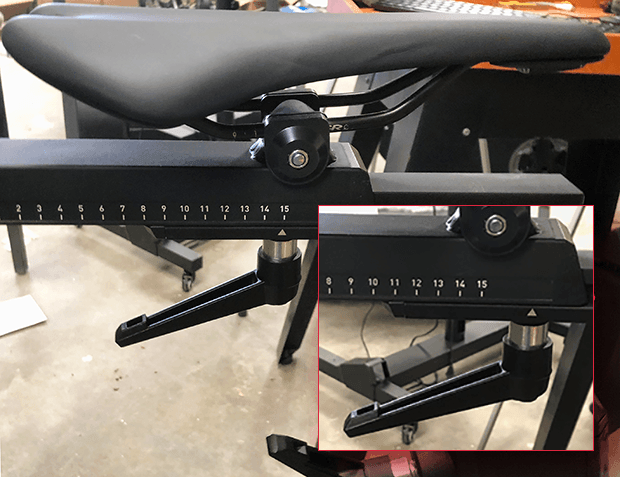
Above, what you’re looking at is my saddle position on this bike. The saddle pushed almost all the way back, to the “15” marker. But my saddle position is not atypically rearward. My saddle nose in this image is about 80mm behind the BB. This means if you’re riding with tri bars on this bike you do NOT need to worry about getting the saddle far enough forward! But a lot of taller guys ride with the saddle nose more than 80mm behind the BB.
Inset in that image above is the saddle adjusted all the way back. That’s an extra 2.5cm rearward, behind the “15” laser etch mark. So, with a typical saddle in the center of its rails, you have about 110mm of saddle-nose plumb line setback. That’s okay. That’ll take care of 49 out of 50 of you. But I’d have made the bike a little differently.
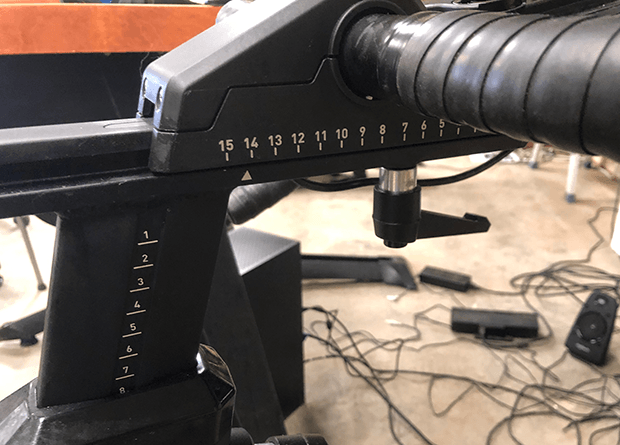
Likewise, my handlebar is pushed about as far forward as I can get it (above). But my handlebars are not that far forward of the BB. My “HX” – the horizontal distance from the BB to the handlebar clamp – is about 490mm. Yes, you can put the bars a little further forward on this bike, and you can always place another handlebar in there, that has a longer “reach” from handlebar clamp to the hooks.
But this – curiously to me – is an issue common to both the KICKR Bike and the NEO Bike: They each are very height adjustable, and the saddle can go down to a BB-to-saddle-top distance of about 635mm (i.e., if you’re 5-feet tall you should be good, and if you’re 6’6” you should be good, saddle height-wise). But both bikes lack the sort of fore/aft adjustability that equals that massive up/down adjustability. That said, the great majority of you will fit fine on this bike, and part of that is because most non-hardcore road racers are not fit very well on their road race bikes. Most need a longer (and lower) position than they currently use, therefore these smart bikes are plenty long for the (sub-optimized) positions many or most employ. If you are a hardcore racer, you'll still find the front end long enough most likely. Just, again, I'd have made both the NEO and the KICKR Bike adjust a few cms more length-adjustable in the front.
This exhausts my list of negatives. How do they rate? Honestly? The positives of this bike are so positive as to render the negatives annoyances rather than deal breakers. As you know by now, if you read what I’ve been writing about stationary devices in 2020, the products of the year, by far, are the two smart bikes I’ve ridden. Whatever product is in third place is so far back a Varia radar can’t even find it.
Adjustability
The primary values to this class of bike – the smart bike – are: First, the adjustability. If this bike is used by, say, you and the spouse, and if you use the same pedal system and crank length you might, maybe, find some way to stretch out the process of changing it over, fitwise, to 3 minutes.
Even better, you can adjust your position while you’re riding this bike. And I mean, while you’re pedaling. Do you ever wonder while riding whether you’d like to have your stem 1cm longer or shorter? Bikes like the NEO give you great instant feedback on whether you want that or not, because you can literally make that “stem” change as you’re pedaling. The NEO Bike is especially good for this because it’s got lock-down handles easy to operate while you’re aboard the bike (in the image below, 4 handles, 2 front and 2 rear). One side benefit of this feature is that I hope we can get riders to improve the road bike positions because their aboard a bike that so easily and quickly accommodates positional experiments.
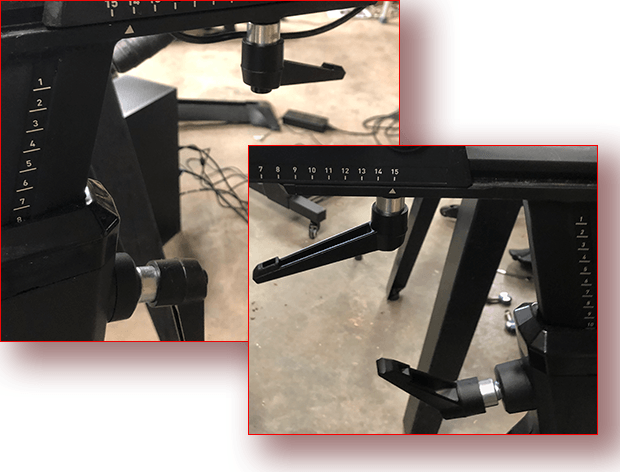
Shifting
The second big deal about smart bikes is that the shifting is virtual. You don’t have to worry about mis-shifts, and you can choose whatever shifting you want. You program the gear ranges into the bike, which means you can change the shifting when you change courses. You neither need to change gearing on the trainer – there are no gears per se – nor do you ever run out of gears. The only issue is that multiple BLE signal thing. You can’t change your “virtual cassette” during an event, if you’ve got a BLE connection to the event, because the Tacx Utility App doesn’t support multiple BLE connections at this time. And by the way, about that Tacx Utility App, below are 3 of the screenshots from my iPhone showing settings available to you.
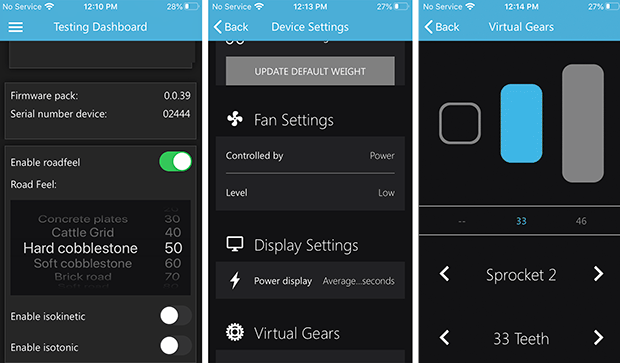
Below is what the console display looks like with a tablet showing Tacx Films, which is the very nice, very high quality, library of videos Tacx offers. What you see is the NEO Bike’s built-in console displaying the metrics produced by or identified by the bike. Inset into this image is what my NEO Bike console displays. Just this. Just the gearing. Why? Because I’m spending pretty much all my time in Zwift, and Zwift is showing me everything I need to see other than the gearing.

When I get on this bike, I feel like I’m strapped on, locked in, solid, perfect. Perfect. The problems with this bike are mostly just what it doesn’t do (yet). Different shift patterns. Multiple BLE connections. Other than incline, and a dodgier-than-necessary method for changing crank lengths, these issues are solved with firmware fixes. For example, today you can program in the shifting you want on the NEO bike, including 12-speed, but you can’t program in a 10-tooth 1st position cog. Why 12-speed but not 10-tooth, since this is the cog you’re likely to have in that 1st position if you’re riding 12-speed? So, firmware upgrades. This will take today’s already ridiculously cool NEO Bike and make it cooler yet.
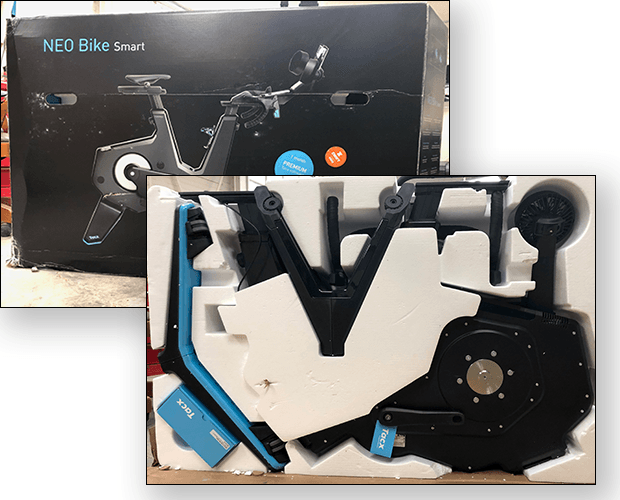
As for how you get this bike, do not worry about getting it mail order. Tacx packages this as if it was shipping 120 pounds of nitro glycerin. They could drop this from a plane onto your front yard, with no parachute, and the box would protect the cargo. It’s easy to put together, and quick. And intuitive. It’ll take you about an hour to get up and running. Above is what the box looks like, and inset into that image is what the box looks like with one side of the box peeled away. That is a massive stryrofoam block, silhoutettes of the bike’s assemblies carved into it.
The NEO Bike by Tacx costs $3,200. Where do you get one of these? MyBikeShop has them available in June, and freight free, which is the best deal by several hundred dollars that I’ve seen. So far, what I’ve noticed is that this bike (and the KICKR Bike) are not getting more available, but less, that is, the lead times are stretching, not shrinking. If you want to read about this bike from Tacx, here’s the company website page on this bike.


